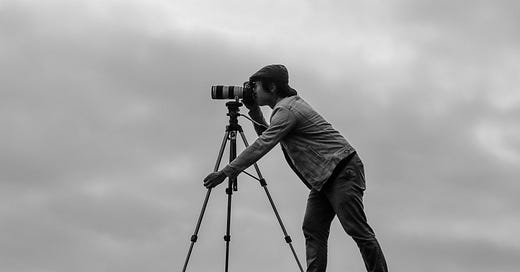The Importance of a Tripod and When to Use One
Unlock Greater Sharpness, Stability, and Creative Control in Your Photography
Photo by Tom Pumford on Unsplash
A tripod is one of the most underrated tools in photography. Many beginners overlook it, thinking it's only for professionals or specific genres like landscape or product photography. But in reality, a tripod is a foundational tool—helping you achieve sharper images, smoother compositions, and greater creative flexibility.
Whether you're shooting in low light, doing long exposures, or composing deliberate, detail-rich images, a tripod can elevate the quality and professionalism of your photography dramatically.
In this article, let's explore why a tripod matters, when to use one, and how it contributes to producing aesthetic and professional-quality photographs.
📷 Why is a Tripod Important in Photography?
✅ 1. Ensures Sharpness and Stability
Even the steadiest hands can introduce small movements that result in blur, especially at slow shutter speeds. A tripod eliminates this completely, ensuring tack-sharp images—even in challenging conditions.
✅ 2. Enables Long Exposure Photography
From silky waterfalls to dreamy night skies, long exposures require the camera to remain perfectly still for several seconds or even minutes. A tripod is non-negotiable in these situations.
✅ 3. Improves Composition
Using a tripod encourages you to slow down, compose your shot with intention, and pay attention to finer details like alignment, horizon level, and background elements.
✅ 4. Ideal for Low-Light Conditions
In situations like early mornings, late evenings, or indoor settings, a tripod allows you to use slower shutter speeds without increasing ISO (which would add noise).
✅ 5. Essential for HDR, Panoramas, and Focus Stacking
These techniques require multiple frames to be aligned precisely. A tripod ensures perfect consistency across exposures or focus points.
✅ 6. Helpful for Video Recording
For stable footage, time-lapse, or slow pans, a tripod provides smooth, shake-free video output.
🏞️ When Should You Use a Tripod?
🌄 1. Landscape Photography
For capturing maximum depth, sharpness, and detail across the frame, especially in low light or when using small apertures (f/11–f/16), a tripod is invaluable.
🌃 2. Night Photography & Astro Photography
Long shutter speeds are essential for low-light scenes, star trails, and light painting. A tripod ensures zero vibration.
💧 3. Waterfalls, Rivers, and Motion Blur
To achieve that soft, silky effect in moving water, a tripod supports slow shutter speeds like 1s, 5s, or even 30s.
🏙️ 4. Architectural Photography
Helps maintain perspective and alignment, especially when composing complex urban scenes or using tilt-shift lenses.
🖼️ 5. Product, Food, and Macro Photography
Fine adjustments, shallow depth of field, and precision framing all benefit from the steadiness of a tripod.
🧍 6. Self-Portraits and Group Shots
Set the timer or use a remote trigger with your tripod for hands-free shooting.
🧰 Choosing the Right Tripod
When selecting a tripod, consider:
Weight and Portability: Aluminum is affordable and strong; carbon fiber is lighter but costlier.
Height and Stability: Should reach eye level and hold your camera gear securely.
Head Type: Ball heads offer quick adjustments; pan-tilt heads are ideal for video and precise control.
Load Capacity: Ensure it supports your heaviest camera and lens combination.
Investing in a good-quality tripod pays off for years to come.
🛠️ Pro Tips for Using Your Tripod Effectively
Use a Remote Trigger or Self-Timer: Avoid camera shake when pressing the shutter.
Turn Off Image Stabilization (IS/VR): It’s not needed on a tripod and may create blur.
Weigh It Down: Hang a bag from the center column for added stability in windy conditions.
Level Your Horizon: Use the built-in spirit level or camera gridlines.
Lock Everything: Double-check all clamps and joints before shooting.
🚫 When You Might Not Need a Tripod
While tripods are extremely useful, they can be skipped in certain scenarios:
Street Photography or Events: Where mobility and spontaneity matter more than stability.
High-Speed Shutter Conditions: Bright daylight with fast shutter speeds (1/500s+) often eliminates motion blur.
Travel and Candid Shots: Where carrying extra weight may hinder your agility.
In these cases, image stabilization (IBIS or lens-based) and proper hand-holding technique can be sufficient.
🖼️ Creative Possibilities Unlocked with a Tripod
Multiple Exposures and Light Trails
HDR and Exposure Bracketing
Timelapse and Stop-Motion
Focus Stacking for Macro and Product Shots
Cinematic Video Capture
The artistic freedom and control a tripod offers are virtually endless.
🌟 Final Thoughts: Build Your Foundation with a Tripod
A tripod isn't just a support tool—it's a gateway to mastery and creative expression. It brings stability to your images, forces you to slow down and compose intentionally, and opens the door to advanced techniques that are impossible to execute by hand.
If you're serious about producing aesthetic, sharp, and professional-quality images, learning to work with a tripod is not optional—it’s essential.
🚀 Join My Photography Community!
Want to deepen your understanding of tools like tripods, master manual settings, and consistently produce gallery-worthy photos?
Join my exclusive photography community and gain access to:
📚 Step-by-step Tutorials: Learn techniques like long exposure, HDR, and composition fundamentals.
🎥 Live Masterclasses: Hands-on learning and real-time feedback from an experienced mentor.
🤝 Supportive Creative Network: Collaborate, share, and grow with fellow photography enthusiasts.
👉 Subscribe today and unlock your potential as a photographer!
Let’s create beautiful, meaningful, and technically sound images—together. 📸✨





